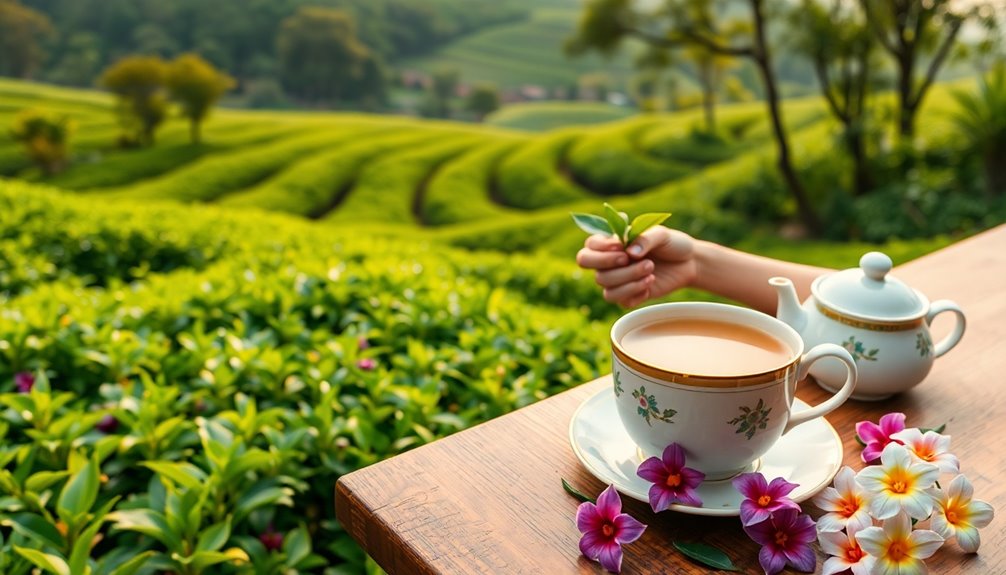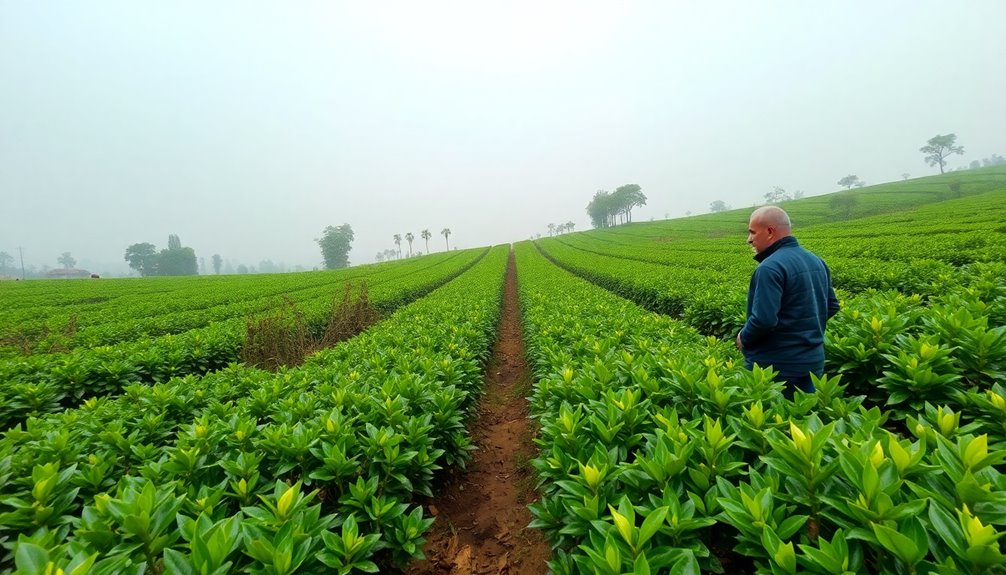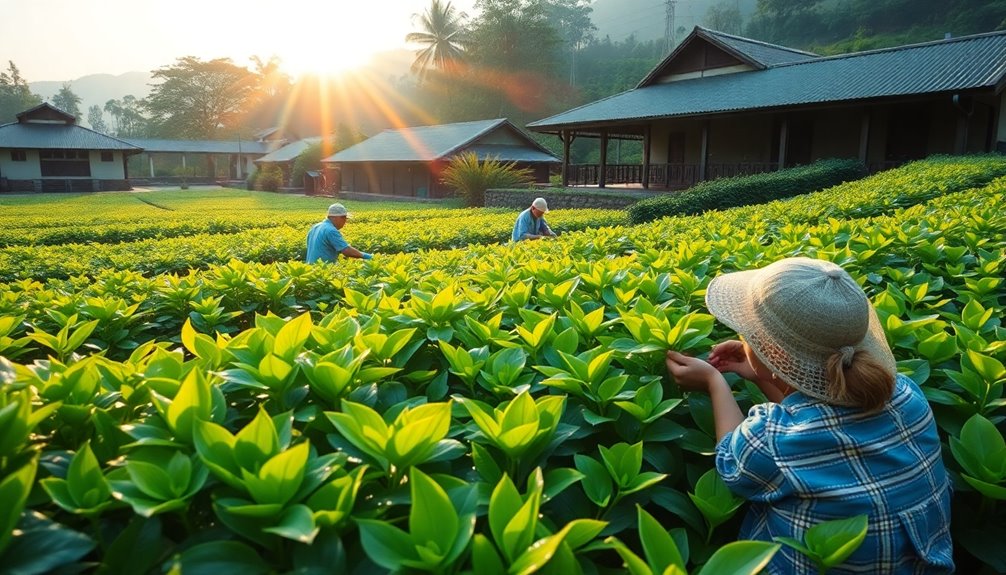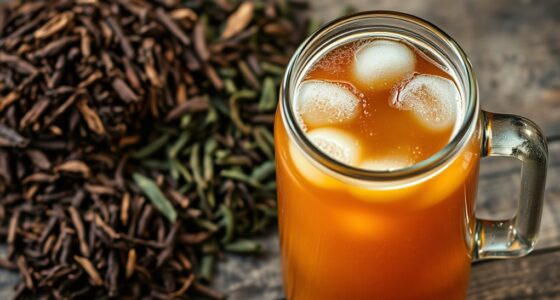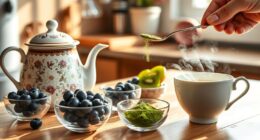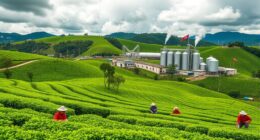Your journey from leaf to cup starts with the lively Camellia sinensis plant. It all begins with harvesting the fresh leaves. Next, they're withered to reduce moisture and then rolled to release their delightful flavors. After that, the leaves undergo oxidation, which changes their color and taste—this is where green and black teas become unique! Finally, they're dried to seal in those amazing flavors. Every step is crucial in creating the tea you love. Plus, there's so much more to discover about tea farming and how it affects the world. You won't want to miss it!
Key Takeaways
- Tea production starts with the Camellia sinensis plant, which is cultivated in various regions worldwide for different tea types.
- The leaves undergo a wither process to reduce moisture before they are rolled and shaped to release essential oils.
- Oxidation alters the leaves' color and flavor, resulting in distinct tea varieties like green, oolong, and black tea.
- Finally, the leaves are dried to lock in flavors, ensuring a rich sensory experience in the final product.
- Sustainable farming practices and fair labor conditions are crucial for high-quality tea production and worker welfare.
Introduction
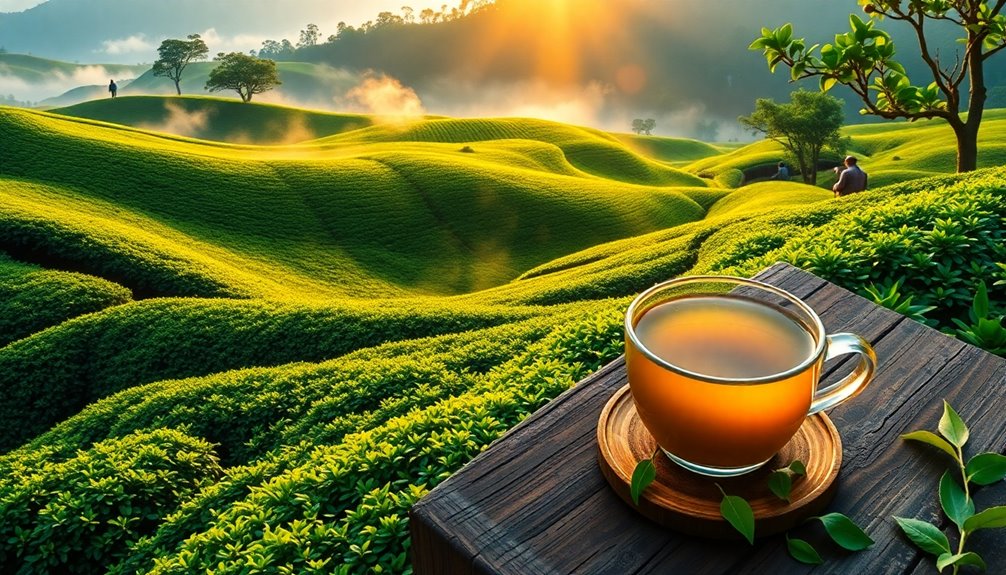
Making tea is a fascinating journey that begins long before it reaches your cup. It all starts with the tea leaves, fresh and vibrant, waiting to be picked. You might be surprised to learn that different types of tea come from the same plant! Yes, it's true! The Camellia sinensis plant produces green, black, white, and oolong teas, depending on how the leaves are processed.
Once the leaves are harvested, they undergo several steps. First, they're withered to reduce moisture. Next, the leaves are rolled and shaped, releasing their essential oils and flavors. This is where the magic begins!
After that, the leaves are oxidized, a process that changes their color and taste. Finally, they're dried, locking in all those delicious flavors you love.
When you brew your tea, you're not just making a drink; you're enjoying a piece of history and culture. Each cup holds stories of the people who grew and processed the tea.
Tea Cultivation Regions Worldwide
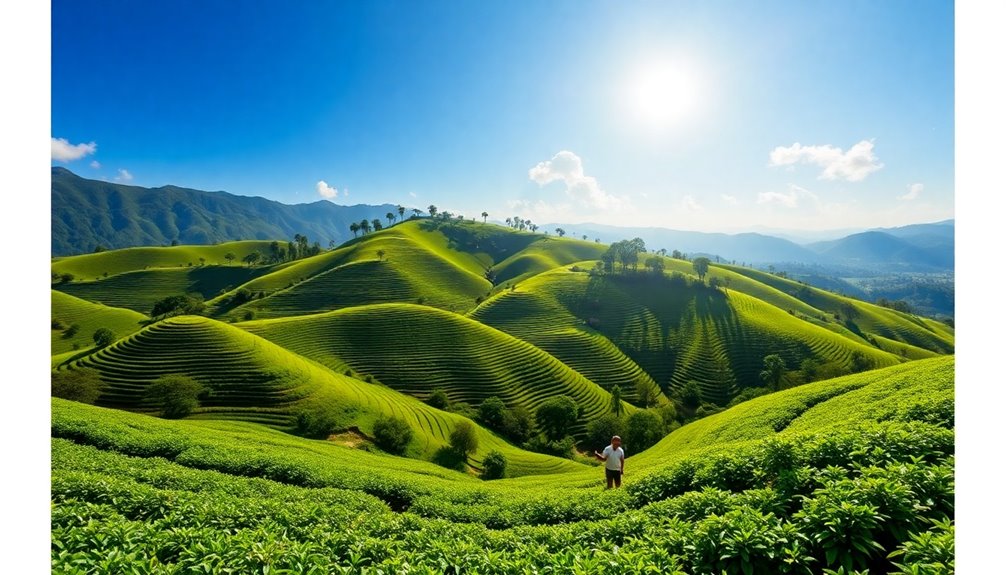
Tea cultivation thrives in several key regions around the world, each contributing unique flavors and characteristics to the leaves. When you sip your favorite tea, you mightn't realize that its journey starts in places like China, India, and Kenya.
In China, the rich soil and misty mountains create perfect conditions for delicate green and fragrant jasmine teas.
India is famous for its Assam and Darjeeling teas, which have bold, robust flavors. If you've ever tried a cup of Assam, you know how rich and malty it can be! On the other hand, Darjeeling offers a lighter, floral taste that many tea lovers adore.
Then there's Kenya, known for its bright and brisk black teas. These teas often have a lively flavor, making them a great choice for a morning boost.
Other regions, like Japan and Sri Lanka, also play a vital role in tea cultivation. Japanese teas bring a fresh, grassy taste, while Sri Lankan teas, often called Ceylon tea, boast a wide range of flavors.
Each region's unique climate and soil contribute to the wonderful variety of tea we enjoy every day!
Tea Oxidation Levels Vary Significantly
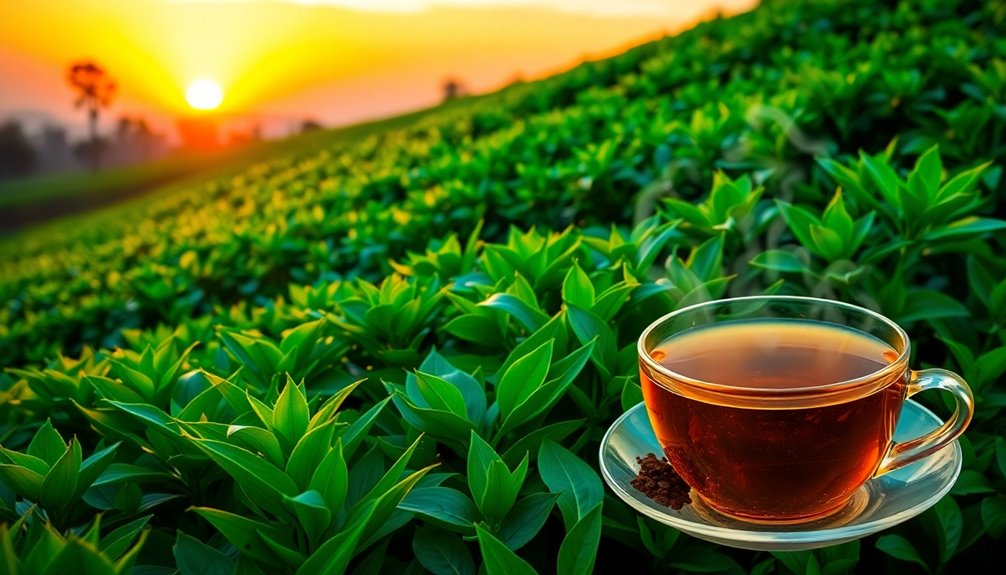
The process of oxidation plays a crucial role in determining the flavor and color of your tea. When tea leaves are picked, they start to react with the air. This reaction is called oxidation, and it can change the tea's taste in exciting ways!
Depending on how long the leaves are allowed to oxidize, you can enjoy different types of tea.
If the leaves are lightly oxidized, like in green tea, you'll find a fresh and grassy flavor. On the other hand, if the leaves oxidize for a longer time, like in black tea, you'll taste a rich and bold flavor instead.
Oolong tea falls somewhere in between, offering a delightful mix of both!
Each oxidation level creates a unique experience for your taste buds. Isn't that amazing? You can explore a whole world of flavors just by choosing a different type of tea!
Sustainable Tea Farming Practices
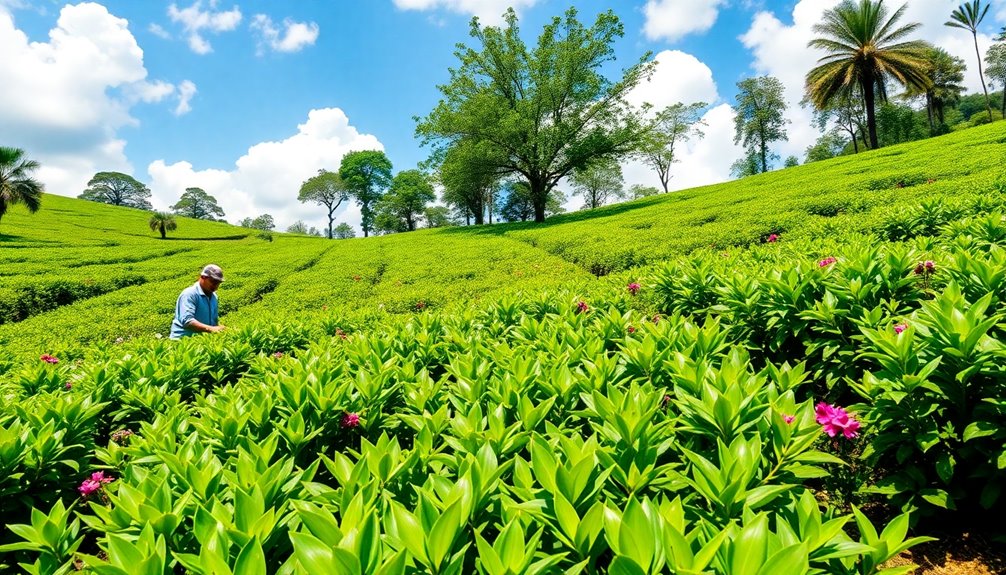
Sustainable tea farming practices are essential for ensuring that your favorite beverage can be enjoyed for generations to come. These practices focus on protecting the environment while growing tea. When farmers use natural fertilizers and avoid harmful chemicals, they help keep the soil healthy and the air clean. This means that when you sip your tea, you're supporting a healthier planet!
Another important aspect is water management. Farmers often collect rainwater and use it wisely, ensuring that they don't waste this precious resource.
By planting trees around tea fields, they not only provide shade for the tea plants but also create homes for birds and other wildlife. This biodiversity is vital for a balanced ecosystem.
Moreover, many farmers are now using organic methods, which means they grow tea without synthetic pesticides. This choice benefits both the environment and your health. Additionally, sustainable practices often involve the use of herbal tea varieties that promote soil health and biodiversity, contributing to a more resilient farming system.
Labor Practices in Tea Production
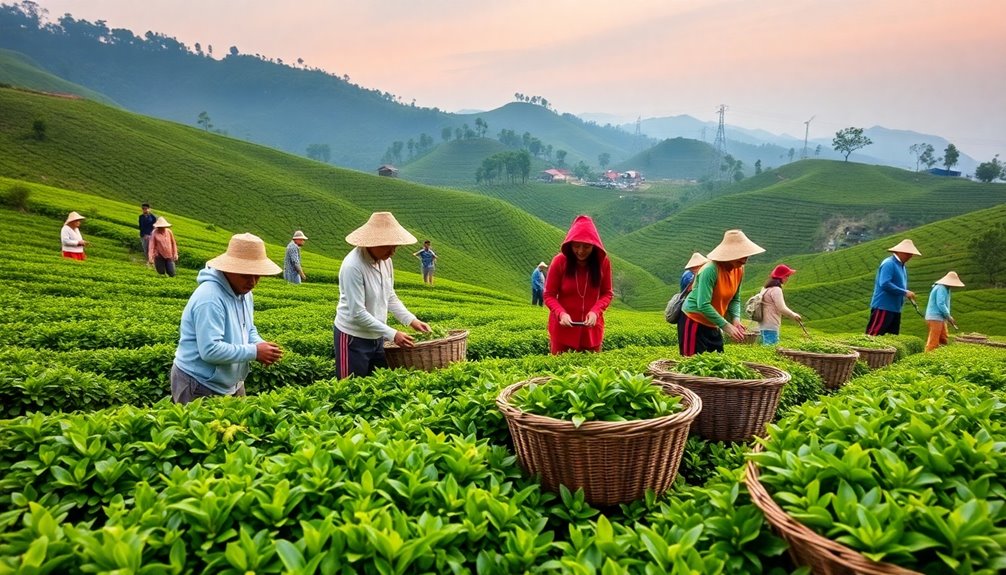
Ensuring fair labor practices in tea production is crucial for the well-being of workers and the overall quality of the tea you enjoy. When workers are treated well, they feel valued and motivated. This leads to better care of the tea plants and, ultimately, a more delicious cup of tea for you!
In many places, tea workers face tough conditions and long hours. They often earn very little money, making it hard for them to provide for their families. It's important to support brands that prioritize fair wages and decent working conditions. When you choose tea from companies that treat their workers right, you help improve lives.
Additionally, fair labor practices mean safer working environments. Workers should have access to clean water, proper tools, and health care. This not only keeps them healthy but also boosts the quality of the tea. Happy, healthy workers produce better tea!
Practical Applications
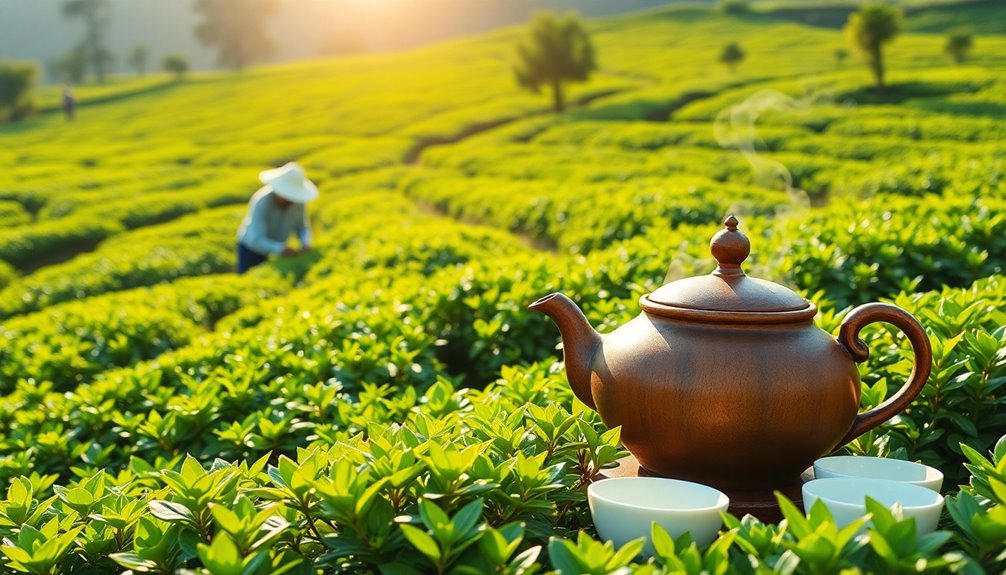
When you dive into the world of tea, understanding practical applications can enhance your appreciation and impact. Knowing how to brew the perfect cup is just the beginning! You can explore different types of tea, like green, black, and herbal, each offering unique flavors and benefits.
Start by choosing high-quality leaves, whether loose or bagged. The right tea can make all the difference. Next, pay attention to water temperature. For example, green tea is best brewed with cooler water, while black tea needs hot water.
Timing is crucial too! Steeping for too long can lead to bitterness, so follow the recommended times.
Don't forget to experiment! You can add a slice of lemon, honey, or even spices like cinnamon to create your own special blend. Also, consider the health benefits. Drinking tea can help with relaxation, digestion, and even boost your mood.
Lastly, share your tea journey with friends! Host a tea party or gift a unique blend. By applying these tips, you'll not only enjoy your tea more but also connect with others over this delightful beverage. Cheers to your tea adventure!
Frequently Asked Questions
How Do Different Brewing Methods Affect Tea Flavor?
Different brewing methods can really change how your tea tastes!
When you use hot water, it brings out strong flavors, while cooler water makes a gentler taste.
Steeping longer can create a bolder flavor, but if you steep too long, it might get bitter.
You can also try different temperatures or times for a fun surprise!
Experimenting with these methods helps you discover which flavors you love the most.
Enjoy the adventure!
What Are the Health Benefits of Drinking Tea?
Drinking tea is like giving your body a special treat!
It's packed with antioxidants, which help keep you healthy. Tea can boost your energy and improve focus, making you feel great during the day.
Plus, some teas can help with digestion and even soothe a sore throat. Isn't that wonderful?
Can Tea Expire or Go Bad?
Yes, tea can expire or go bad, but it usually lasts a long time if stored properly.
When you keep it in a cool, dry place away from sunlight, it stays fresh.
Look for signs like smell or color changes. If it loses its yummy aroma or looks dull, it's best to toss it.
Remember, while old tea won't harm you, it mightn't taste as great.
Enjoy your perfect cup!
How Should I Store My Loose Leaf Tea?
To store your loose leaf tea, keep it in a cool, dark place.
Use an airtight container, like a tin or jar, to protect it from moisture and light.
Make sure it's labeled with the type and date you bought it.
Avoid keeping it near strong odors, as tea can easily absorb smells.
With these tips, you'll keep your tea fresh and flavorful, ready for your next delightful cup!
Enjoy every sip!
What Is the Best Water Temperature for Brewing Tea?
The best water temperature for brewing tea really depends on the type you're using!
For delicate green teas, aim for around 175°F (80°C), while black teas thrive at about 200°F (93°C).
Herbal teas can handle boiling water at 212°F (100°C).
Using the right temperature helps bring out the delicious flavors, so don't skip this step!
Experiment a little, and you'll discover your perfect cup of tea. Enjoy!
Conclusion
Now that you know how tea goes from leaf to cup, you can truly appreciate each sip! Whether it's grown in sunny gardens or picked by hard-working hands, every cup tells a story. By choosing sustainable teas, you're helping the planet and supporting farmers. Next time you make your favorite brew, think about all the care that went into it. So, grab your mug, enjoy your tea, and share the joy with friends!

